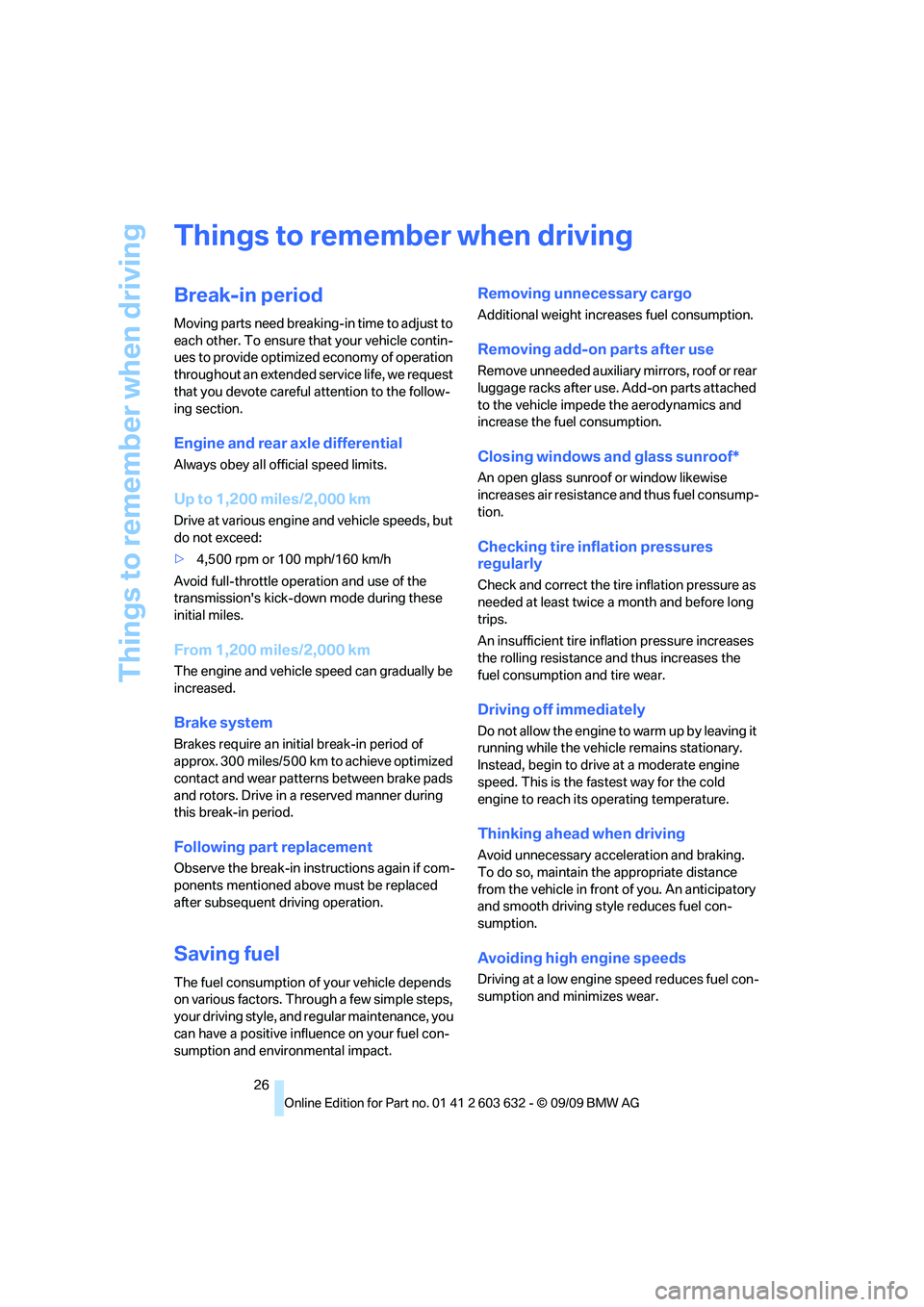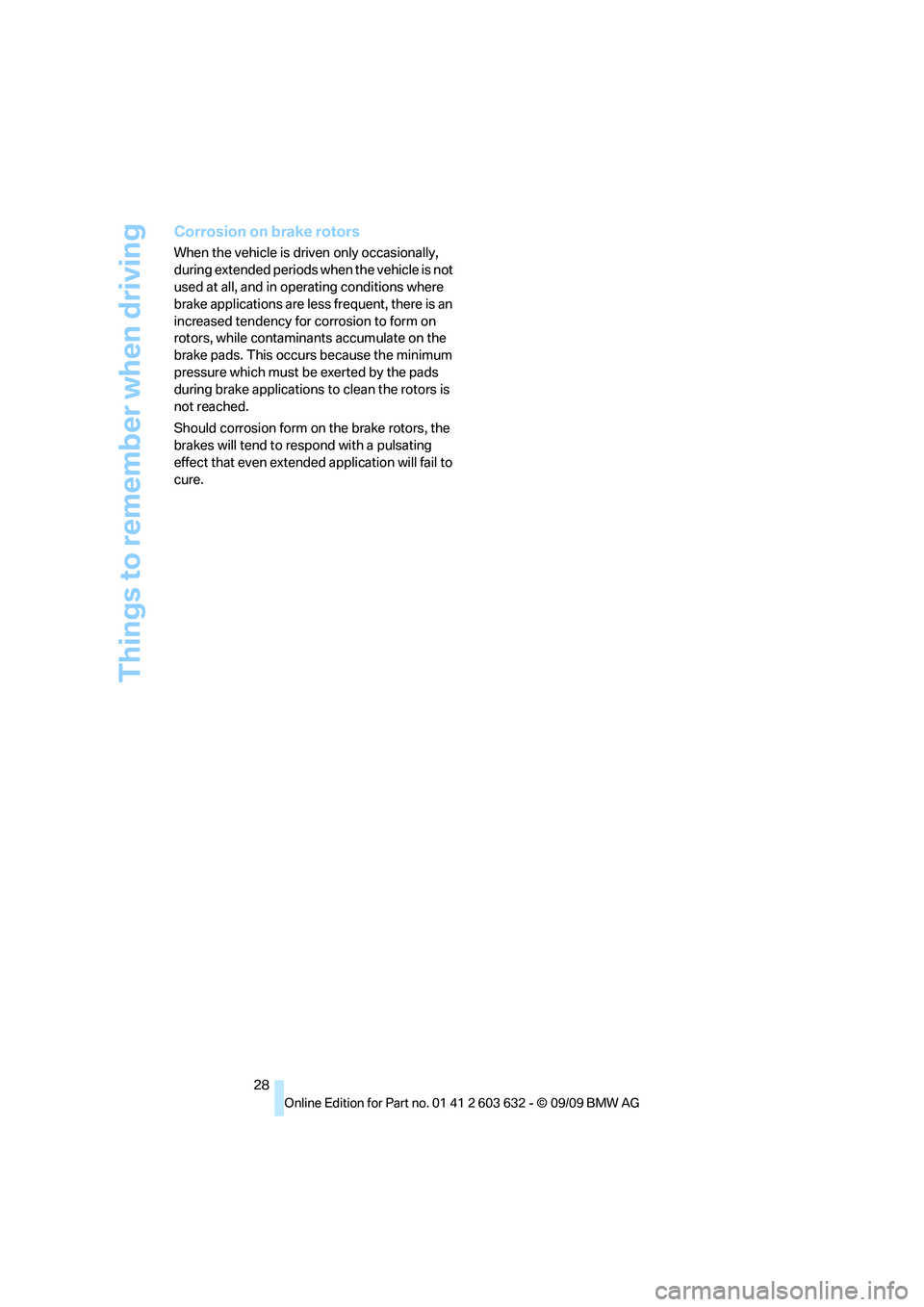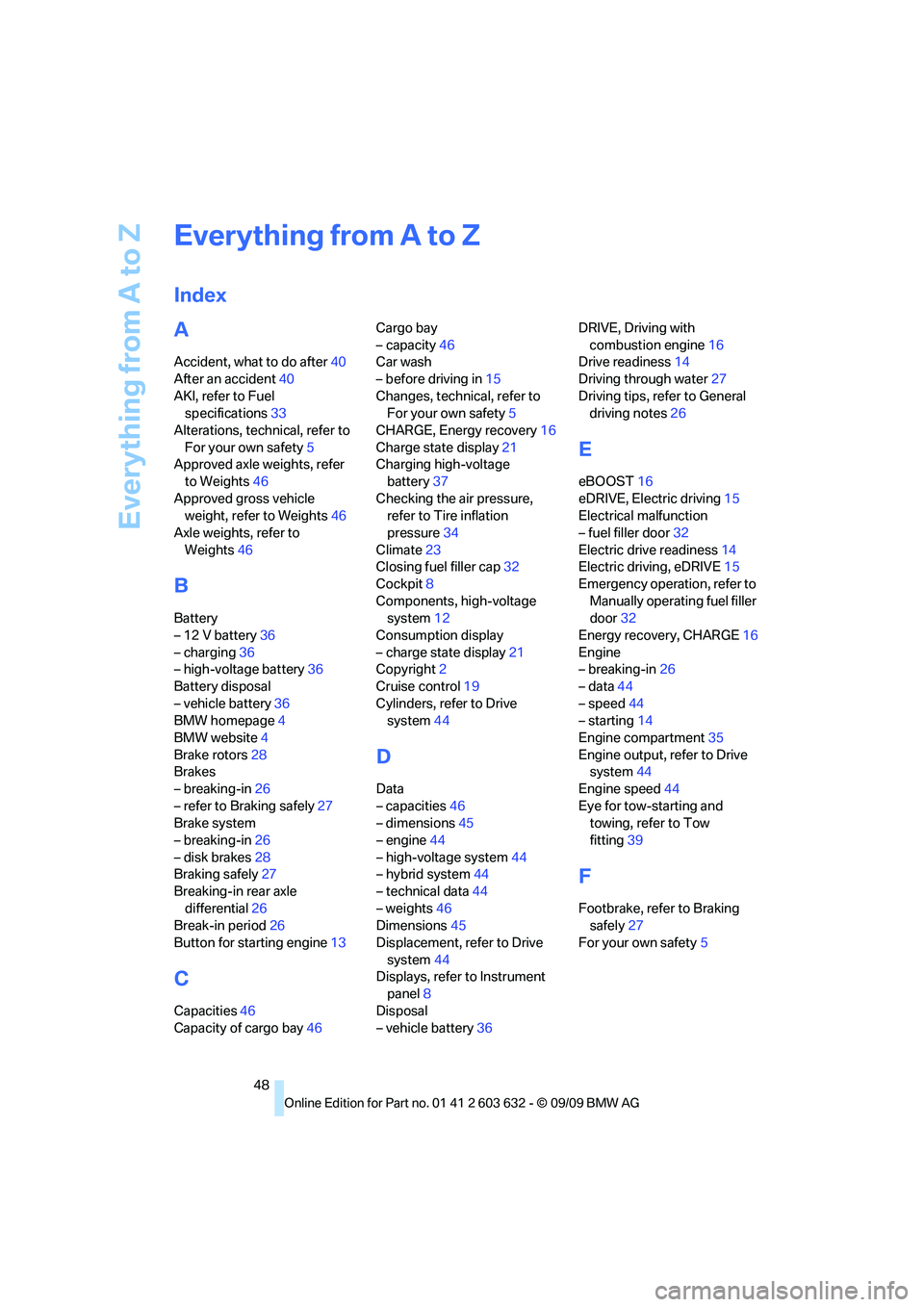brake rotor BMW ACTIVEHYBRID X6 2010 Owners Manual
[x] Cancel search | Manufacturer: BMW, Model Year: 2010, Model line: ACTIVEHYBRID X6, Model: BMW ACTIVEHYBRID X6 2010Pages: 54, PDF Size: 3.16 MB
Page 28 of 54

Things to remember when driving
26
Things to remember when driving
Break-in period
Moving parts need breaking-in time to adjust to
each other. To ensure that your vehicle contin-
ues to provide optimized economy of operation
throughout an extended service life, we request
that you devote careful attention to the follow-
ing section.
Engine and rear axle differential
Always obey all official speed limits.
Up to 1,200 miles/2,000 km
Drive at various engine and vehicle speeds, but
do not exceed:
>4,500 rpm or 100 mph/160 km/h
Avoid full-throttle operation and use of the
transmission's kick-down mode during these
initial miles.
From 1,200 miles/2,000 km
The engine and vehicle speed can gradually be
increased.
Brake system
Brakes require an initial break-in period of
approx. 300 miles/500 km to achieve optimized
contact and wear patterns between brake pads
and rotors. Drive in a reserved manner during
this break-in period.
Following part replacement
Observe the break-in instructions again if com-
ponents mentioned above must be replaced
after subsequent driving operation.
Saving fuel
The fuel consumption of your vehicle depends
on various factors. Through a few simple steps,
your driving style, and regular maintenance, you
can have a positive influence on your fuel con-
sumption and environmental impact.
Removing unnecessary cargo
Additional weight increases fuel consumption.
Removing add-on parts after use
Remove unneeded auxiliary mirrors, roof or rear
luggage racks after use. Add-on parts attached
to the vehicle impede the aerodynamics and
increase the fuel consumption.
Closing windows and glass sunroof*
An open glass sunroof or window likewise
increases air resistance and thus fuel consump-
tion.
Checking tire inflation pressures
regularly
Check and correct the tire inflation pressure as
needed at least twice a month and before long
trips.
An insufficient tire inflation pressure increases
the rolling resistance and thus increases the
fuel consumption and tire wear.
Driving off immediately
Do not allow the engine to warm up by leaving it
running while the vehicle remains stationary.
Instead, begin to drive at a moderate engine
speed. This is the fastest way for the cold
engine to reach its operating temperature.
Thinking ahead when driving
Avoid unnecessary acceleration and braking.
To do so, maintain the appropriate distance
from the vehicle in front of you. An anticipatory
and smooth driving style reduces fuel con-
sumption.
Avoiding high engine speeds
Driving at a low engine speed reduces fuel con-
sumption and minimizes wear.
Page 30 of 54

Things to remember when driving
28
Corrosion on brake rotors
When the vehicle is driven only occasionally,
during extended periods when the vehicle is not
used at all, and in operating conditions where
brake applications are less frequent, there is an
increased tendency for corrosion to form on
rotors, while contaminants accumulate on the
brake pads. This occurs because the minimum
pressure which must be exerted by the pads
during brake applications to clean the rotors is
not reached.
Should corrosion form on the brake rotors, the
brakes will tend to respond with a pulsating
effect that even extended application will fail to
cure.
Page 50 of 54

Everything from A to Z
48
Everything from A to Z
Index
A
Accident, what to do after40
After an accident40
AKI, refer to Fuel
specifications33
Alterations, technical, refer to
For your own safety5
Approved axle weights, refer
to Weights46
Approved gross vehicle
weight, refer to Weights46
Axle weights, refer to
Weights46
B
Battery
– 12 V battery36
– charging36
– high-voltage battery36
Battery disposal
– vehicle battery36
BMW homepage4
BMW website4
Brake rotors28
Brakes
– breaking-in26
– refer to Braking safely27
Brake system
– breaking-in26
– disk brakes28
Braking safely27
Breaking-in rear axle
differential26
Break-in period26
Button for starting engine13
C
Capacities46
Capacity of cargo bay46Cargo bay
– capacity46
Car wash
– before driving in15
Changes, technical, refer to
For your own safety5
CHARGE, Energy recovery16
Charge state display21
Charging high-voltage
battery37
Checking the air pressure,
refer to Tire inflation
pressure34
Climate23
Closing fuel filler cap32
Cockpit8
Components, high-voltage
system12
Consumption display
– charge state display21
Copyright2
Cruise control19
Cylinders, refer to Drive
system44
D
Data
– capacities46
– dimensions45
– engine44
– high-voltage system44
– hybrid system44
– technical data44
– weights46
Dimensions45
Displacement, refer to Drive
system44
Displays, refer to Instrument
panel8
Disposal
– vehicle battery36DRIVE, Driving with
combustion engine16
Drive readiness14
Driving through water27
Driving tips, refer to General
driving notes26
E
eBOOST16
eDRIVE, Electric driving15
Electrical malfunction
– fuel filler door32
Electric drive readiness14
Electric driving, eDRIVE15
Emergency operation, refer to
Manually operating fuel filler
door32
Energy recovery, CHARGE16
Engine
– breaking-in26
– data44
– speed44
– starting14
Engine compartment35
Engine output, refer to Drive
system44
Engine speed44
Eye for tow-starting and
towing, refer to Tow
fitting39
F
Footbrake, refer to Braking
safely27
For your own safety5